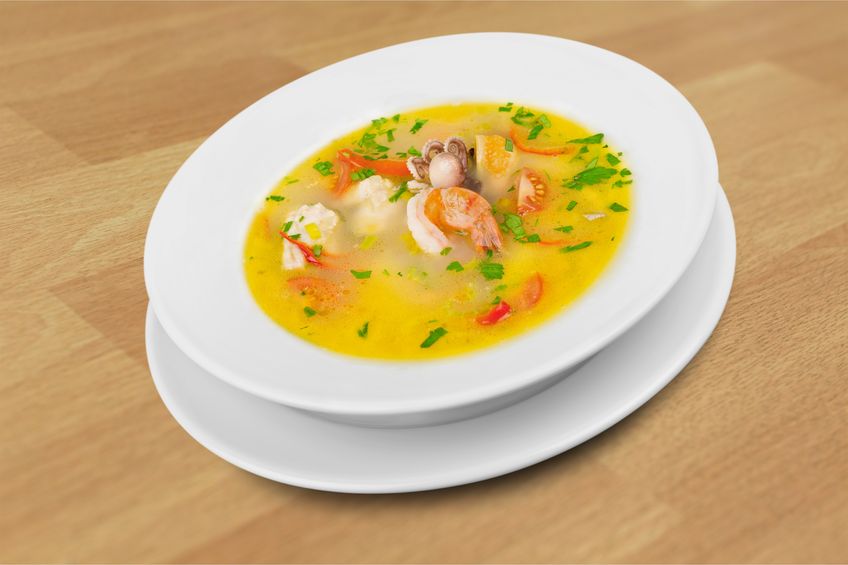Pho (Fuuuh) –LOADED with Nutrients!
As the leaves change colors and the air outside becomes cool and crisp, I can’t help but crave soup. Soup can be an excellent platform to introduce a variety of vegetables as well as different protein sources. Adding flavorful spices such as ginger, garlic, cilantro, etc can aid in digestion or help boost immune function.
One of my favorite cold weather soups as the Vietnamese staple, Pho (pronounced Fuuuuuuh).
Where is Pho from?
Pho originated in the early 20th century in northern Vietnam. The traditional home of pho is reputed to be the villages of Vân Cù and Dao Cù.
Pho was originally sold at dawn and dusk by roaming street vendors, who shouldered mobile kitchens on carrying poles (gánh phở). From the pole hung two wooden cabinets, one housing a cauldron over a wood fire, the other storing noodles, spices, cookware, and space to prepare a bowl of pho.
Phở tái, served with beef cooked rare, had been introduced by 1930. Chicken pho appeared in 1939, possibly because beef was not sold at the markets on Mondays and Fridays at the time.
With the Partition of Vietnam in 1954, over a million people fled North Vietnam for the South. Pho, previously unpopular in the South, suddenly took off. No longer confined to northern culinary traditions, variations in meat and broth appeared, and additional garnishes, such as lime, bean sprouts, cilantro (ngò gai), cinnamon basil (húng quế), and Hoisin sauce (tương đen), became standard fare. Phở tái also began to rival fully cooked phở chín in popularity
Meanwhile, in North Vietnam, private pho restaurants were nationalized (mậu dịch quốc doanh) and began serving pho noodles made from old rice, while street vendors were expected to use noodles made of imported potato flour.
When did it enter the U.S.?
In the aftermath of the Vietnam War, Vietnamese refugees brought pho to many countries. Restaurants specializing in pho appeared in numerous Asian enclaves and Little Saigons, such as in Paris and in major cities in Canada, the United States, and Australia.
In the United States, pho began to enter the mainstream during the 1990s, as relations between the U.S. and Vietnam improved. At that time Vietnamese restaurants began opening quickly in Texas and California, spreading rapidly along the Gulf and West Coasts, as well as the East Coast and the rest of the country. During the 2000s, pho restaurants in the United States generated an estimate of $500 million in annual revenue.
The word pho was added to the Shorter Oxford English Dictionary in 2007. Pho is listed at number 28 on “World’s 50 most delicious foods” compiled by CNN Go in 2011.
When I make pho at home, I take the “easy” route and use chicken broth with the ingredients listed below. If you want to taste the “real deal” I suggest going to a local Vietnamese restaurant or venture over to Serious Eats find out how to make legit, traditional Pho—oxtail and all J. My husband always orders rare-steak Pho, while I tend to stick with shrimp and chicken. Below, I’ve listed the ingredients that I usually put in along with some fun facts detailing why they’re actually good for me!
Health Benefits of Pho Ingredients
Cilantro
- Its deep-green leaves possess good amounts of antioxidants, essential oils, vitamins, and dietary fiber, which help reduce LDL or “bad cholesterol” while rising HDL or “good cholesterol” levels.
- The herb is a good source of minerals like potassium, calcium, manganese, iron, and magnesium. Potassium is an important component of cell and body fluids that helps control heart rate and blood pressure. Iron is essential for red blood cell production. Manganese is used by the body as a co-factor for the antioxidant enzyme,superoxide dismutase.
- It is also rich in many vital vitamins, including folic-acid, riboflavin, niacin, vitamin-A, beta carotene, vitamin-C, which are essential for optimum health. Vitamin-C is a powerful natural antioxidant. 100 g of cilantro leaves provide 30% of daily recommended levels of vitamin-C.
- It provides 6748 IU ofvitamin-A per 100 g, about 225% of recommended daily intake. Vitamin-A, an important fat soluble vitamin and anti-oxidant, is also required for maintaining healthy mucus membranes and skin and is also essential for vision. Consumption of natural foods rich in vitamin-A and flavonoids (carotenes) helps body protect from lung and oral cavity cancers.
- Cilantro is one of the richestherbal sources for vitamin K; provide about 258% of DRI. Vitamin-K has a potential role in bone mass building by promoting osteotrophic activity in the bones. It also has established role in the treatment of Alzheimer’s disease patients by limiting neuronal damage in their brain.
Ginger
- Ginger has been in use since ancient times for its anti-inflammatory, carminative, anti-flatulent, and anti-microbial properties.
- The root contains health benefiting essential oils that help improve the intestinal motility and have been anti-inflammatory, painkiller (analgesic), nerve soothing, anti-pyretic as well as anti-bacterial properties. Studies have shown that it may decrease nausea induced by motion sickness or pregnancy and may help relieve migraine headache.
- Zingerone, a chemical compound which gives pungent character to the ginger root, is effective against E.coli induced diarrhea, especially in children.
- It contains a good amount of minerals like potassium, manganese, copper, and magnesium. Potassium is an important component of cell and body fluids that helps controlling heart rate and blood pressure.
- Ginger root slices, boiled in water with lemon or orange juice, and honey, is a popular herbal drink in ayurvedic medicine to relieve common cold, cough, and sore throat (Perfect for Flu season!!).
Bok Choy
- Bok choy is one of the popular leafy-vegetables very low in calories. Nonetheless, it is very rich source of many vital phyto-nutrients, vitamins, minerals and health-benefiting anti-oxidants.
- As in other Brassica family vegetables, bok choy too contains certain anti-oxidant plant chemicals likethiocyanates, indole-3-carbinol, lutein, zea-xanthin, sulforaphane and isothiocyanates. Along with dietary fiber, vitamins these compounds help to protect against breast, colon, and prostate cancers and help reduce LDL or “bad cholesterol” levels in the blood.
- It is an excellent source of water-soluble antioxidant,vitamin-C (ascorbic acid). 100 g provides 45 mg or 75 % of daily requirements of vitamin C. Regular consumption of foods rich in vitamin C helps the body develop resistance against infectious agents and scavenge harmful, pro-inflammatory free radicals.
- Bok-choy has more vitamin A, carotenes, and other anti-oxidants than cabbage, cauliflower, etc. Just 100 g of fresh vegetable provides 149% of daily-required levels vitamin A.
- It is a very good source ofvitamin K, provides about 38% of RDA levels. Vitamin-K has a potential role in bone metabolism by promoting osteotrophic activity in bone cells. Therefore, enough vitamin K in the diet makes your bone stronger, healthier and delay osteoporosis. Further, vitamin-K also has established role in curing Alzheimer’s disease patients by limiting neuronal damage in their brain.
- Fresh bok choy has many vital B-complex vitamins such as pyridoxine (vitamin B6), riboflavin, pantothenic acid (vitamin B5), pyridoxine, and thiamin (vitamin B-1). These vitamins are essential in the sense that our body requires them from external sources to replenish.
Shrimp
- Shrimp is an excellent source of selenium, this neutralizes the effects of free radicals( which are the main cause of cancer and other degenerative diseases).
- Shrimp is an excellent source of protein, a four ounce serving of shrimp supplies 23.7 grams.
- Shrimp is a very good source of vitamin D. This vitamin regulates the absorption of calcium and phosphorus, which is essential for strong teeth and bones.
- Shrimp has anti-inflammatory qualities that can help reduce gum swelling.
- Shrimp is a good source of vitamin B12. This vitamin is important for the proper brain function and essential for the formation and maturation of blood cells.
- Shrimp is also a good source of omega-3 fatty acids which reduce the risk of cardiovascular problems because it reduces cholesterol in the blood.( Omega-3 fatty acids can also ease the symptoms of PMS, avoid blood clots, prevent the development of rheumatoid arthritis, slows the growth of cancerous tumors, and helps prevent Alzheimer’s disease)
Chicken
- Lean organic chicken is a very good source of high density, low fat protein, and a good source of selenium, zinc, niacin, Vitamin E, beta-carotene, and Vitamins B6 and B12.
- Chicken, like its brother fowl the turkey, is high in an amino acid called tryptophan, which gives you that comforting feeling after consuming a big bowl of mom’s chicken soup. In fact, if you’re feeling depressed, eating some poultry will increase the serotonin levels in your brain, enhance your mood, blasting stress, and lulling you to sleep.
- Homocysteine is an amino acid that can cause cardiovascular disease if levels are high in the body. Believe it or not, eating chicken breast suppresses and controls homocysteine levels.
- Chicken is also rich in phosphorus, an essential mineral that supports your teeth and bones, as well as kidney, liver, and central nervous system function.
- Like shrimp, Chicken also abundant in selenium, an essential mineral involved in metabolic performance—in other words thyroid, hormone, metabolism, and immune function.
Jalapeño
- Chilies contain health benefiting alkaloid compound,capsaicin, which gives them strong spicy pungent character. Capsaicin has been found to have anti-bacterial, anti-carcinogenic, analgesic, and anti-diabetic properties,. It also found to reduce LDL-cholesterol levels in obese individuals.
- Fresh jalapeno peppers are rich source ofvitamin-C. Vitamin C is a potent water-soluble antioxidant. It is required for the collagen synthesis within the body. Collagen is the main structural protein required for maintaining the integrity of blood vessels, skin, tissues, organs, and bones. Regular consumption of foods rich in vitamin C helps the body protect from scurvy; develop resistance against infectious agents (boosts immunity) and scavenge harmful, pro-inflammatory free-radicals from the body.
- Jalapeno chilies characteristically contain more pyridoxine, vitamin E, vitamin K than other varieties of peppers. Vitamin K increases bone mass by promoting osteotrophic activity in the bones. It also has the beneficial effect inAlzheimer’s disease patients by limiting neuronal damage in their brain.
As the weather gets colder, I’ll bring more nutrient dense soup recipes for you to try! Until then, if you have a lazy night—venture to a local Vietnamese restaurant and give this comforting, soothing soup a try! If you’re feeling ambitious, make it at home. The wonderful thing about soups is that you can throw ANYTHING in. Add additional veggies such as broccoli, spinach, carrots, asparagus and mushrooms for extra phytonutrient power!
References:
1.http://www.medicalnewstoday.com/articles/280948.php
2. https://www.organicfacts.net/health-benefits/animal-product/health-benefits-of-chicken.html
3. http://www.seriouseats.com/2012/09/the-food-lab-how-to-make-traditional-vietnamese-pho.html
4. https://www.vietnamparadisetravel.com/blog/enjoy-ha-noi-pho-like-the-gourmet
5. http://www.whfoods.com/genpage.php?tname=foodspice&dbid=72












